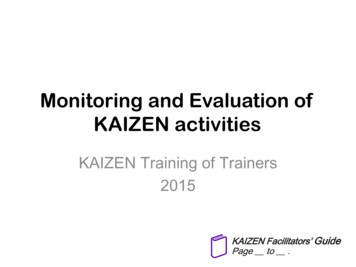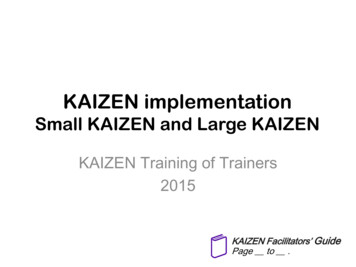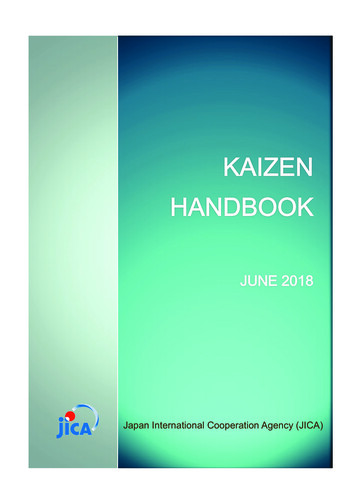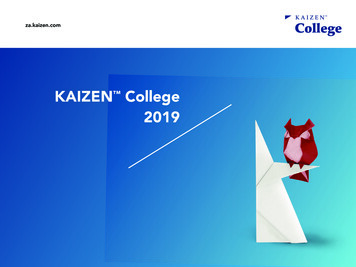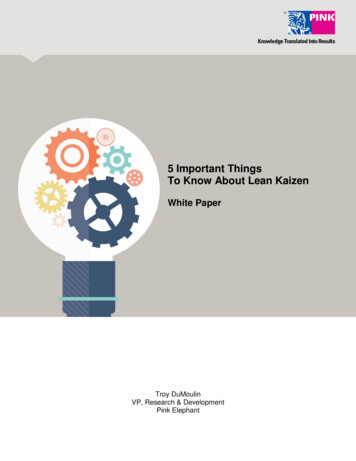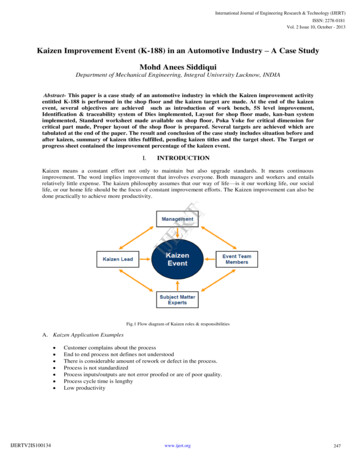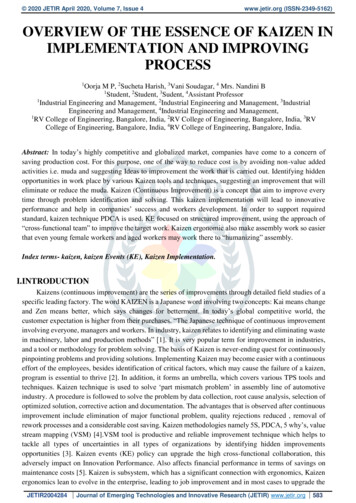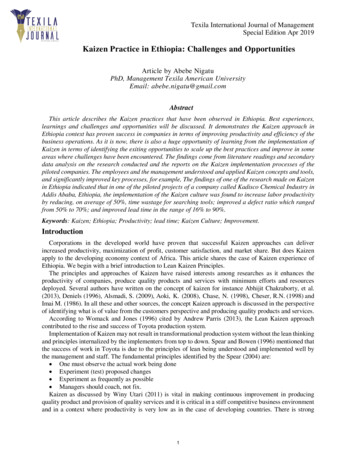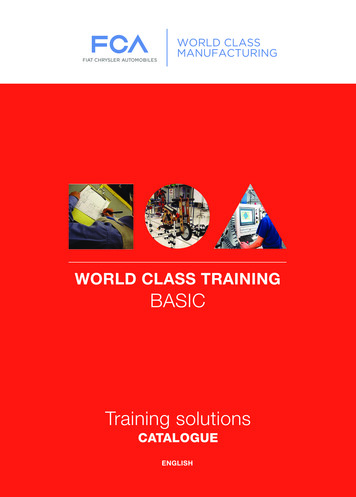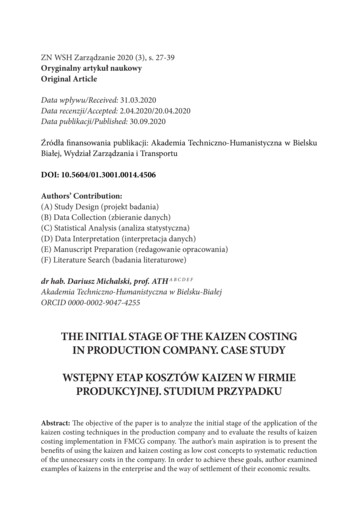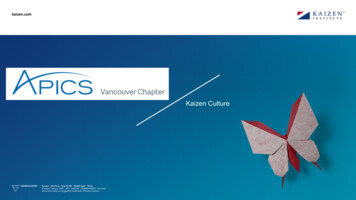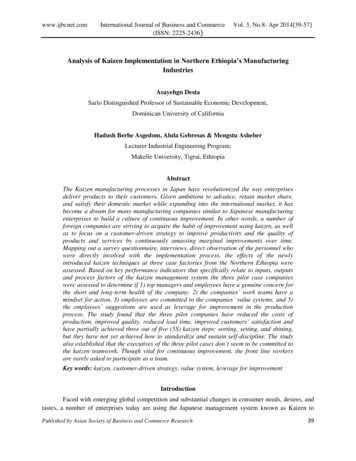
Transcription
www.ijbcnet.comInternational Journal of Business and Commerce(ISSN: 2225-2436)Vol. 3, No.8: Apr 2014[39-57]Analysis of Kaizen Implementation in Northern Ethiopia’s ManufacturingIndustriesAsayehgn DestaSarlo Distinguished Professor of Sustainable Economic Development,Dominican University of CaliforniaHadush Berhe Asgedom, Alula Gebresas & Mengstu AsheberLecturer Industrial Engineering Program;Makelle University, Tigrai, EthiopiaAbstractThe Kaizen manufacturing processes in Japan have revolutionized the way enterprisesdeliver products to their customers. Given ambitions to advance, retain market share,and satisfy their domestic market while expanding into the international market, it hasbecome a dream for many manufacturing companies similar to Japanese manufacturingenterprises to build a culture of continuous improvement. In other words, a number offoreign companies are striving to acquire the habit of improvement using kaizen, as wellas to focus on a customer-driven strategy to improve productivity and the quality ofproducts and services by continuously amassing marginal improvements over time.Mapping out a survey questionnaire, interviews, direct observation of the personnel whowere directly involved with the implementation process, the effects of the newlyintroduced kaizen techniques at three case factories from the Northern Ethiopia wereassessed. Based on key performance indicators that specifically relate to inputs, outputsand process factors of the kaizen management system the three pilot case companieswere assessed to determine if 1) top managers and employees have a genuine concern forthe short and long-term health of the company, 2) the companies’ work teams have amindset for action, 3) employees are committed to the companies’ value systems, and 5)the employees’ suggestions are used as leverage for improvement in the productionprocess. The study found that the three pilot companies have reduced the costs ofproduction, improved quality, reduced lead time, improved customers’ satisfaction andhave partially achieved three out of five (5S) kaizen steps: sorting, setting, and shining,but they have not yet achieved how to standardize and sustain self-discipline. The studyalso established that the executives of the three pilot cases don’t seem to be committed tothe kaizen teamwork. Though vital for continuous improvement, the front line workersare rarely asked to participate as a team.Key words: kaizen, customer-driven strategy, value system, leverage for improvementIntroductionFaced with emerging global competition and substantial changes in consumer needs, desires, andtastes, a number of enterprises today are using the Japanese management system known as Kaizen toPublished by Asian Society of Business and Commerce Research39
www.ijbcnet.comInternational Journal of Business and Commerce(ISSN: 2225-2436)Vol. 3, No.8: Apr 2014[39-57]make adjustments to re-engineer their manufacturing processes to meet these needs. The dynamic kaizenstrategy is an activity of continually revolving cycles of Plan, Do, Check and Act (PDCA) which focus oncustomer-driven processes to improve productivity and the quality of products and services by amassingmarginal improvements over time.A number of manufacturing industries in Ethiopia currently are not using methods that willachieve high productivity and excellent quality standards to make them more competitive in theglobalized, international markets. Most of the initiatives taken for quality and productivity improvementare through top-down approaches without the best management skills. Many manufacturing companiesare plagued by such problems as high quality rejects, high inventories, long lead time of production, highcosts of production, and inability to cope with customer orders.Given these problems and appreciating that kaizen, the manufacturing process used in Japan, hasrevolutionized the way enterprises deliver products to their customers, retain market share, and satisfytheir domestic market and expand into the international market, a number of enterprises in northernEthiopia are attempting to develop the habits of kaizen to focus on a customer-driven strategy to improveproductivity and the quality of products and services by continuously amassing marginal improvementsover time.The implementation of the kaizen management techniques could enable enterprises in NorthernEthiopia to identify and solve their current manufacturing problems without employing high-techapproaches, only involving people on the shop floor in kaizen activities. Three pilot companies have beenstudied, the Mesfin Industrial Engineering PLC, Almeda Textile Factory PLC., and Sheba Leather andTanning Industry PLC, which have implemented the kaizen management system to revitalize theirmanagement system. Thus, the central question of the study is: How efficient and effective are the kaizenstrategic management initiatives, tools, and methods for improvement in these three pilot projects inNorthern Ethiopia?The purpose of this study is to: 1) map out the degree of awareness of three companies of thekaizen management strategy, 2) assess the mindset for action in the working teams of the threecompanies, 3) measure the institutionalization of the kaizen process to ensure continuous improvement inthe production of quality products and services, 4) investigate how the organizational structure of thethree companies accepts employee inputs and leverages their suggestions for improvement, 5) analyze thecommitment of top managers at the three companies to the short and long-term health of their enterprises.The awareness of kaizen, its implementation process, and the effects of using this strategicmanagement system in the three companies are measured through performance indicators generated fromquestionnaires, interviews, direct observation, factory developed metric systems, and published recordsby the companies’ resource planning and research centers.Review of the LiteratureFrom the ashes of the Second World War, Japan through its culturally embedded, innovative managementsystem has succeeded in rebuilding its economy and is now emulated by the community of nations(Waheed et al., 2010). For example, in the 1980s, the manufacturing industry in Japan showed significantgrowth through the adoption of the kaizen process of management strategies. Its key objective has been toembed the process into the work culture to achieve a never-ending drive toward increasing productivity,Published by Asian Society of Business and Commerce Research40
www.ijbcnet.comInternational Journal of Business and Commerce(ISSN: 2225-2436)Vol. 3, No.8: Apr 2014[39-57]efficiency, and quality improvement. Today, the kaizen management system is spreading throughout theworld. It has become a goal for many manufacturing companies to build a culture of continuouscommitment to improvement.Many non-Japanese companies are initiating a kaizen management strategy without adequatelytaking into consideration its own cultural roots. Thus, they face many barriers while they are chasing thisdream. As stated by Brunet and New (2003), it has not been clear hitherto how firms in other cultures canmaintain the momentum for kaizen activities, nor how the concepts of target setting, control andincentives for participants fit into their overall management system. The Toyota Total Production System(TPS) sees problems as opportunities to improve, seeking root causes by asking what, why, and whoquestions. Companies from other cultures visualize problems as discrepancies between the currentsituation and the standardized ideal that can only be solved by management. In addition, while the ToyotaTPS, sees that qualities are customer driven, other cultures view that whatever they supply to the marketcan be sold, thinking they have produced to the needs of consumers (see for example, Ohno, T. andBodek, N, 1988; EPA, November 200; and Ahmed,S; Hasan,M; Fen,Y, 2005).Despite these glaring and challenging problems, in order to stay competitive in an increasinglyglobal market place and with an increase in customer demands, a number of foreign companies areforced to rethink their manufacturing and management approach to lower costs of production, minimizewaste, improve productivity, boost quality, and achieve sustainability. Thus, if top management of kaizencompanies in other cultures has the desire to thrive for a healthy long term, before starting on a kaizentransition, management needs to be passionately committed to undertaking an assessment of its owninternal and external conditions. Also, it needs to see if it has tailored its activities to meet domestic andglobal customers. In addition, when transferred to other cultures, companies need to use dedicated crossfunctional teams to improve a targeted manufacturing work area (Melnyk et al., 1998, Kirby and Greene,2003, and Heizer & Render, 2010).Therefore, since well established kaizen strategies help companies to control cost, minimizeworkers motion, focus on zero defects and, more fundamentally, improve workers’ skills by creating acooperative atmosphere where everyone becomes fully aware of the key goals, each step of the kaizenprocess needs to be mapped out and measured to ensure economic value to its customers. As stated byGlover et al (2008) since kaizen teams apply structured process tools and human creativity with a goal ofsubstantially improving the performance of the work area, process or product, the team workshop needsto be purposely designed to make jobs easier by taking them apart, studying them, and makingimprovements, creating a culture of continual improvement with well-designed outreach programs toeveryone in the organization (Thessaloniki (2006).Unlike the conventional approach which emphasizes individual work and mainly watches to seeif the worker meets the performance objective of an industry, the kaizen techniques of productionchallenge the status quo and help workers internalize the work, with creativity and emphasis oninstitutionalizing the productivity process. For example, the conventional method of Total QualityManagement (TQM) of production techniques is challenged because after a workshop ― staff were sentback to their regular duties and told to improve the quality of their work process. No one typically thoughttheir process was broken so there wasn’t much incentive to change anything‖ (EPA, November 2007).In short, while the conventional approach emphasizes each worker’s performance, in kaizeneveryone is encouraged to contribute to job improvement. Being process-oriented, kaizen activities arePublished by Asian Society of Business and Commerce Research41
www.ijbcnet.comInternational Journal of Business and Commerce(ISSN: 2225-2436)Vol. 3, No.8: Apr 2014[39-57]based on the assumption that a company’s overall competitiveness will improve in the long run ifindividual variations are reduced. Therefore, before structuring the entire company to kaizenquality/productivity improvement practices, it needs to refine its methodology by ―brain storming,‖ thatis, gathering a group of employees who will contribute spontaneously to list ideas to find a creativesolution for a specific problem. Alex Faickney Osborn (1953) proposed that teams could double theircreative output with brainstorming which works by focusing on a problem, and then coming up with asmany solutions as possible and by pushing the ideas as far as possible.A brainstorming team is composed of at least 12 members with a wide a range of disciplines andexperiences. The team is chosen from the top management level, middle managers, and frontline workersfrom the target work area and includes outside experts to give their own objective initiatives. Then, thebrainstorming team analyzes the vision (the future aspirations of the firm) until it clearly understands themission statement that articulates the firm’s reason for being, its basic purpose, and where it is going.Also, during the brainstorming sessions, all participants are to listen to and respect the ideas andviewpoints expressed by all the participants. In short, in a brainstorming session the ground rules need toinclude: 1) keeping an open mind to change; 2) maintaining a positive attitude; 3) never leaving in silentdisagreement; 4) creating a blameless environment; 5) practicing mutual respect everyday; 6) treatingothers as you want to be treated; 7) one-person – one voice, regardless of position or rank; and 8)understanding that there is no such thing as a dumb question ( EPA, November 2007).With a good understanding and internalized vision of the mission of the enterprise, thebrainstorming team analyzes the current situation and identifies problems using the SWOT analyses of theStrengths, what it is good at doing, or a characteristic that gives an important capability; Weaknesses,what a company lacks or does poorly in comparison to others; Opportunities, the external trends waitingto be taken advantage of; and Threats, the external movements which may cause a problem or have anegative impact on the firm’s business.In short, the purpose of the pre-kaizen stage is to provide a clue to problem-awareness. In theproblem awareness stage, each company is taught that while undertaking a SWOT analysis, the causes ofhigh priority problems and needs are easily located within the objectives of the organization. As stated byGRIPS, the pre-kaizen awareness stage is supposed to create consciousness and ― foster positiveattitudes and to promote teamwork and recognition for companies problems and individuals‖ (December2011, p. 54). In addition to strong commitment and endorsement by high-level government and privateofficials, pre-kaizen awareness can cause a remarkable mind set change to take place through formaltraining of students at vocational schools, tertiary institutions, worker’s unions, academia and the publicat large. Some community support programs may provide donations, sponsorship and prizes to a widerange of community groups, schools and clubs that require a proactive, ongoing, community-engagementstrategy. Furthermore, regular forums to share knowledge and ideas between the company and the broadercommunity can be maintained through dissemination of publications and postings about productivity thatmay provide the company with a benchmark as it improves its productivity, skills and techniques whencompared with similar companies (GRIPS, 2011).Through a participatory program, a company can find solutions that are in line with the sharedmission and goals of all team members. With the kaizen cross-functional teamwork approach, workersare not only empowered to challenge the status quo but also can gather the most conspicuous internal andexternal factors that could be become part of the work ethics necessary for productivity. The awarenessPublished by Asian Society of Business and Commerce Research42
www.ijbcnet.comInternational Journal of Business and Commerce(ISSN: 2225-2436)Vol. 3, No.8: Apr 2014[39-57]and consciousness created among the employees of a company can be translated into specific action at theworkplace. In addition to generating support for the changes made during the transition, involving targetarea employees in the kaizen event is an investment in employee training and also introduces employeesto specific tools and techniques of lean process improvement to sustain effectively the event-basedchanges, as well as to continue to generate future improvements (Bradley and Willett, 2004).As outlined before, the most compelling reasons for the formation of empowering work teams arethat it: 1) allows an organization to take advantage of the diverse backgrounds, and interests of teammembers, 2) results in a motivated and entrepreneurial workforce, 3) can be made to work well withteams, since everyone can participate on a team, and 4) creates a well-defined, planning process forgiving responsibility to a group of people who know how to do their job well at their level (Thessaloniki(2006).Once the root causes of problems in the process or value stream are identified during the prekaizen process, the team uses the following four pillars of kaizen activities to implement greateroperational efficiency (the cost) and effectiveness (the extent to which customers’ requirements are met).These are: a) housekeeping activities, b) waste elimination or elimination of non-value added materials, c)standardization of workplace environment, and d) mapping out Socio-economic and environmentaleffects of the company, and e) conducting follow-up action plans to evaluate the end results of the kaizenactivities (Ministry of Industry, 2011).a) Housekeeping Activities: The beginning of the kaizen housekeeping journey of managementstarts by displaying a level of orderliness and clarity of the work area using the following FiveSteps (5S). As stated by Imai, 5S is a set of techniques that provide a standard approach to goodhousekeeping and fosters an increase in quality and productivity (Imai, 1997 as quoted in Juhariet al (2011). If an organization wants to ensure continued competitiveness and achieve marketgrowth, it needs to start with the following 5S system: a) sorting or gathering the spear materialsneeded by the company, selling what is not needed to a scrap dealer or putting them into trash; b)setting or straightening, keeping visible the remaining materials or parts to provide a pleasingappearance; c) shining and spreading the clean products; d) standardizing and consistentlyimplementing the new process; and e) sustaining improvement using the Six Sigma targets forquality improvements, variation, and safety. Taking a ―customer service‖ attitude kaizen attemptsto present value stream mapping (VSM) to deliver the desired outcomes, services or products tocustomers, and improve staff morale and ascertain the transparency of the process.Though a number of manufacturing firms try to carry out the 5S System, an ongoing process, thelack of sustained motivation is one of the factors that hinders the successful implementation of the 5SSystem. Therefore, to effectively apply the 5S System, Juhari, Abidin, and Omar (2011) suggest thatcommunication for 5S , training for 5S, reward and recognition for 5S and top management support for5S are vital factors that influence employees’ motivation in the implementation of the 5S System. Giventhis, they suggest that management needs to pay attention and invent effective strategies to motivate theiremployees on a consistent basis. In their study they have ascertained that the four independent variablesthat influence employees’ motivation for environmental improvement and the implementation of the 5Ssystems include, knowing the goals of the firm, management support, employee involvement andexperiential training, and employees’ reward and recognition.Published by Asian Society of Business and Commerce Research43
www.ijbcnet.comInternational Journal of Business and Commerce(ISSN: 2225-2436)Vol. 3, No.8: Apr 2014[39-57]b) Waste Elimination: Muda or elimination of non-value adding activities includes removingunnecessary wastes caused by people and machine. Muda or waste can accumulate because acompany may have more than necessary equipment, materials or people for quantity production.The way to eliminate waste in any company is therefore to make employees aware in advancewhich steps add value to the product, and which steps do not. Generally, the seven types ofdeadly wastes (muda) as identified by the Toyota Production System (TPS) that accumulate in acompany’s production system are caused by 1) overproduction, 2) waiting, 3) transportation, 4)inventory, 5) over processing, 6) motion, and 7) production of defective parts. In addition, in thesugar plantation and production process, extra wastage is accumulated as a result of theinfiltration of excessive nutrients into ground water or surface waters that naturally contribute togreenhouse-gas emissions (Lean in Government Series, November 2007).1)Muda from overproduction occurs when a company produces too soon or too muchproduct in order to be on the safe side in case of a machine’s failure and/or employeeabsenteeism. As a result, trying to produce more than needed products creates misuse ofraw materials, wasteful inputs of manpower, utilities, an increased burden on interestpayments, added transportation, additional space needed to store excess inventory andadministrative costs (See, Thawani, 2003 and Thessaloniki, 2006). As stated byMezgebe, Asgedom, and Desta (2013) any company can minimize overproduction bytrying to be consistent in understanding the heartbeat of the consumer, making demandassessments for the particular product even if the product has been commercialized for along period of time. Demand is dynamic and tuning the production scheme accordingly isimportant, so continuous communication with customers is one way of reducingoverproduction.2)Waiting Waste: This occurs when the hands of the operator are idle, or when anoperator’s work is put on hold because of a lack of parts, waiting for the next piece toarrive. It can also happen when another worker slows up the line, anything that lengthensthe lead time of the product from start to finish. As narrated by Thessaloniki, (2006)―Lead time begins when the company pays for its raw materials and supplies, and endswhen the company receives payment from customers for products sold. Since lead timerepresents the turnover of money, a shorter lead time means better use of resources, moreflexibility in meeting customer needs, and of course contributes to the lowering ofoperation costs.3)Transportation: This is a non-essential part of operations. A company might use trucks,forklifts, or conveyors as a means of transportation. Unnecessary transport of damagedmaterials (muda) contributes to waste because transportation does not add value to thefinished product. As stated by Thawani (2003) one way of minimizing waste is byincorporating the act of any process into the main line.4)Inventory: An excess of final product, semi-finished product, raw materials and spareparts kept in inventory contributes to Muda of inventory. They do not add value. Instead,they add to the cost of operations by occupying space, requiring additional equipment andfacilities such as warehouses and forklifts. As the products stored deteriorate over timethey could eventually become obsolete. Excess items staying in inventory gather dust andtheir quality deteriorates over time. They are even at risk of damage through fire orPublished by Asian Society of Business and Commerce Research44
www.ijbcnet.comInternational Journal of Business and Commerce(ISSN: 2225-2436)Vol. 3, No.8: Apr 2014[39-57]disaster. As suggested by Thessaloniki (2006) Just-in-time (JIT) production systems helpto solve the Muda of inventory.5)Over-processing: This type of Muda uses more resources, utilities, and materials, or usesthe wrong set of tools, procedures or systems. Producing more quantity ahead of schedulecreates waste because in manufacturing a longer line requires more workers, more workin-process and a longer lead-time to produce outputs. As suggested by Thessaloniki(2006), many unneeded workers are likely to make a greater number of mistakes― which leads to quality problems. More workers also mean that a longer lead-time willincrease cost of operations‖ As Suggested by Thawani, (2003) elimination of Muda inprocessing can frequently be avoided by combining operations/steps.6)Motion: Excessive movements by workers like walking, lifting, or carrying heavyobjects, searching for lost items create waste. In short, Muda of motion is unproductivebecause it involves movements by workers not directly related to the job. such as poorworkplace organization, resulting in poor ergonomics, for example excessive bending orstretching (Mezgebe, Asgedom, and Desta, 2013). Thus, ―Workers should avoidwalking, lifting, or carrying heavy objects that require great physical exertion because itis difficult, risky, and represents non-value added activities‖ (Thessaloniki 2006).Rearranging the workplace would eliminate unnecessary human movement and eliminatethe requirement of having another operator to do his/her work more efficiently.7)Production of Defective Parts: Muda of repairs/rejects interrupts production. Itcontributes to a great waste of resources and effort. In addition, rejects increaseinspection work, require expensive rework or additional time to repair (Thessaloniki,2006). The production of defective parts can cause dissatisfied consumers to complainabout their defective product but also might create a skeptical attitude about otherproducts the company may be producing in the future. In order to eliminate non-valueadded defective products, companies could retrain and redirect staff-time to higherpriority activities related to their core mission. A brief review of the types anddescriptions of wastes are given in Table1.Table 1 Type and description of wastes#WasteDescription1OverproductionProducing too much or too soon, resulting from poor flow of information2DefectsFrequent errors, product quality problems, or poor delivery performance3Unnecessary inventoryExcessive inventory because of delay of information or products, resulting in the need for extrastorage4Inappropriate processingGoing about a work process using the wrong set of tools, procedures or systems, when a simplerapproach may be more effective5Excessive transportationExcessive movement of people, information or goods, resulting in wasted time, effort and cost6WaitingLong periods of inactivity for people, information or goods7Unnecessary motionPoor workplace organization, resulting in poor ergonomics, for example excessive bending orstretching, or searching for frequently lost itemsPublished by Asian Society of Business and Commerce Research45
www.ijbcnet.comInternational Journal of Business and Commerce(ISSN: 2225-2436)Vol. 3, No.8: Apr 2014[39-57]Source: See Shigeo Shingo; as quoted by Fawaz A.(2003), ―Lean Manufacturing Tools and Techniquesin the Process Industry with a focus on Steel‖, Published PhD dissertation,, School of Engineering,University of Pittsburg, Pittsburg, USA, pp: 40-50. Mezgebe, T.T , Asgedom, B. H and Desta, A. 2013)―Economic analysis of lean wastes: Case Studies of Textile and garment industries in Ethiopia.”In general, it was suggested by Thawani (2003) that unlike many western approaches such asBusiness Process Re-engineering, Six Sigma which calls for massive investments, the golden rules ofWorkplace Management (Gemba kaizen) is group effort for continuous incremental improvement that canbe standardized by requiring each worker to:ogo to work place first (like a detective) when problems arise;oinvestigate or check the object carefully (e.g. a customer complaint or defective itemproduced/pile loads of inventory);otake temporary counter-measures promptly;ofind the root cause of the problem (e.g. if excess inventory check the purchasing systemor the production management); andodevelop/amend an existing procedure/system to prevent its recurrence.Thus, the adoption of a ―zero defect‖ mindset in the employees of an organization is vital forspontaneously and automatically improving the operations of the firm. Standards are set by managementand engineers. Companies with employee suggestions can bring about improvement as they are called toreview the set standards periodically, collecting information and analyzing defects, and encouragingteams to conduct problem-solving activities to optimize performance, comfort, and safety to meet thecompany’s goals. As stated by Thessaloniki (2006) the standardization of improvement activities mayinclude the following key features if employees: 1) represent the best, easiest, and safest way to do thejob; 2) offer the best way to preserve know-how and expertise; 3) provide a way to measure performance;4) provide a basis for both maintenance and improvement; 5) provide objectives and a basis for employeetraining and motivation; 6) create a basis for auditing or diagnosis; and 7) provide a means for preventingrecurrence of errors and minimizing variability. Thus, the benefits of standardization could a) help thecompany optimize operations, save cost and improve profits, b) enhance customer satisfaction andincrease sales, c) increase market share, and d) reduce negative impacts on the environment.A Conceptual FrameworkBased on the review of the literature, the following conceptual model about the Japanesemanagement system, kaizen, is developed from this review of the literature and establishes theinterrelationships among the factors deemed to be integral to the dynamics of answering the researchquestion. Since the kaizen journey begins with ―housekeeping,‖ management must display a level oforderliness and clarity before kaizen is introduced. Then employees must take a SWOT analysis in orderto have a clear understanding of the root causes of their company’s problems in order to become aware ofthe process, to foster positive attitudes and to promote teamwork. In addition the employees of a companythat is planning to be engaged in a kaizen strategy need to be given training to expose them to the specifictools and techniques of lean process improvement. This will help them to effectively sustain event-basedPublished by Asian Society of Business and Commerce Research46
www.ijbcnet.comInternational Journal of Business and Commerce(ISSN: 2225-2436)Vol. 3, No.8: Apr 2014[39-57]changes as well as generate future improvements. Finally, the team of a group needs to use the followingfour pillars of kaizen activities: a) housekeeping activities, b) waste elimination or elimination of nonvalue added materials, c) standardization of the workplace environment, and d) evaluating the end resultsof the kaizen activities in order to implement even greater operational efficiency (cost-effect) andeffectiveness (refers to the extent to which custo
www.ijbcnet.com International Journal of Business and Commerce Vol. 3, No.8: Apr 2014[39-57] (ISSN: 2225-2436) Published by Asian Society of Business and Commerce Research 39 Analysis of Kaizen Implementation in Northern Ethiopia's Manufacturing Industries
